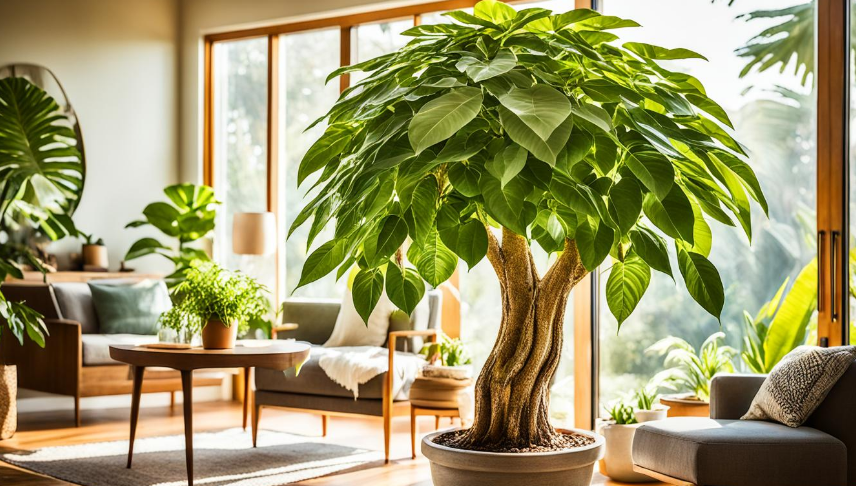Money Tree Meaning & Symbolism

The Money Tree meaning & symbolism are tied to its unique appearance and significant meaning. Many people don’t realize that it’s a combination of several Pachira Aquatica trees braided together as they grow. Native to South and Central America, this broadleaf evergreen can reach up to 60 feet tall in the wild.
It won’t get as tall as an indoor plant, but it still has a remarkable presence. When kept inside, a braided Money Tree can grow anywhere from 1 to 8 feet tall, which is relatively tall compared to other houseplants.
When Did the Money Tree Become Popular?
Contrary to what many believe, the money tree plant didn’t become popular until the 1980s. A truck driver in Taiwan first cultivated it. Since then, it quickly became a symbol of prosperity.
Feng Shui practitioners highly regard the money tree plant, often growing various types such as mini money trees, money tree forests, and larger versions. This makes it easy to find one that meets your preferences and needs.
Spiritual Meaning
The money tree, originating from Taiwan, symbolises abundance, prosperity, and good fortune. It’s associated with strength, power, wealth, and success.
Its braided stem is especially popular because it’s believed to bring additional good luck to those who care for it well.
Giving someone a money tree is thought to bring them happiness and increased wealth. The plant’s bright, glossy leaves add positive and vibrant energy to any home or office.
A popular legend about the money tree‘s origins tells of a man who found a money tree and took it home while down on his luck. He began to cultivate more of these trees and eventually sold them, making a fortune.
This story has helped make the money tree popular, especially in East Asia. In business, the money tree is often given as a gift to symbolize good fortune, with the braided trunk believed to capture and hold onto wealth.
Each stem of the money tree typically has five leaves, symbolizing metal, wind, water, fire, and earth. Occasionally, a stem might have seven leaves, which is considered very lucky, though it’s rare. These traditions and beliefs contribute to the money tree’s overall appeal and widespread popularity.
Is the Money Tree Plant Considered Lucky?
Determining a plant’s impact on luck isn’t straightforward. However, tradition suggests that people who nurture a money tree often experience greater success. Whether this stems from psychological beliefs or actual influence remains a matter of discussion.
Nonetheless, the money tree‘s enduring popularity and symbolic meaning underscore its distinct appeal among plants.
What Does a Money Tree Symbolize as a Gift?
Giving someone a money tree is seen as a gesture of wishing them good fortune and prosperity. It symbolizes a desire for their success and abundance in life’s ventures.
This practice is widely embraced across various cultures, emphasizing the intent to positively influence others’ lives through meaningful presents.
Money Tree vs Money Plant
| Feature | Money Tree (Pachira Aquatica) | Money Plant (Pilea Peperomioides, Crassula ovata, Epipremnum Aureum) |
|---|---|---|
| Species | Pachira Aquatica | Pilea Peperomioides, Crassula ovata, Epipremnum Aureum |
| Appearance | Resembles a tree | Does not resemble a tree |
| Size | Generally larger | Generally smaller |
| Leaves | Fewer leaves | More leaves |
| Commonality | Both are considered lucky | Both are considered lucky |
| Distinct Traits | Braided trunk, glossy leaves | Varied leaf shapes and sizes depending on the species |
The Importance of Six Leaves on a Money Tree
The significance of six leaves on a money tree is rather important. When you observe six leaves on a money plant, it symbolizes good fortune.
It should be noted that a usual money tree generally possesses 5-6 leaves, seldom more. As such, it is advisable to meticulously count and ascertain the exact number of leaves on your money tree.
7 Leaves on a Money Tree
Conversely, if you encounter seven leaves on a money tree stem, it is thought to bring even more luck.
Chinese Money Plant Traditions
Different customs are associated with the Chinese money tree, mostly related to specific cultures. The traditions surrounding the Chinese currency plant are especially fascinating.
The idea is to bury a coin in the soil of your money plant, believing it will attract more prosperity. It’s hard to determine these traditions’ effectiveness, but it’s worth a shot! At the very least, you’ll have a beautiful plant in your home.
However, one should not dismiss the chance that it could bring more wealth and happiness.
What Are the Advantages of Having a Money Tree?
- Symbolic Value: Known to bring wealth, luck, and happiness.
- Air Cleaning: Helps purify the air by removing harmful pollutants.
- Improves Indoor Air: Enhances the overall air quality in your home.
- Effective Pollutant Removal: Clear substances like xylene, benzene, toluene, and formaldehyde.
Conclusion
Whether you regard the Money Tree as a good luck charm or simply admire its beauty, it remains a cherished plant for its aesthetic appeal and deeper meaning. The Money Tree meaning & symbolism continue to captivate and inspire people worldwide.
Some FAQs on Money Tree Meaning & Symbolism
Q1: What does a money tree symbolize?
A1: The Money Tree symbolises prosperity and good fortune, and it is believed to attract wealth and business success. People often give it as a gesture of respect or with hopes for blessings and spiritual guidance.
Q2: What do 7 leaves on a money tree mean?
A2: Seven leaves on a money tree symbolize increased good fortune. While most money trees typically have five or six leaves per stem, encountering one with seven leaves is believed to bring added luck. If you come across such a rare find, it’s often considered auspicious, prompting some to try their luck with a lottery ticket.
Q3: What is the superstition about money trees?
A3: The superstition surrounding money trees is rooted in their reputed ability to attract good luck and prosperity to a household. According to Nikole Washington Nelson, a floral merchandiser at Harry & David, these trees are believed to bring positive energy and financial success, although money doesn’t grow on them.
Q4: Where should a money tree be placed?
A4: When deciding where to place your money tree in your home, choose a spot with bright, indirect sunlight. Money trees also thrive in fluorescent light, making them suitable for bathrooms or offices. Avoid placing them near vents or drafts to ensure they don’t experience sudden temperature changes.
Q5: Is it good to keep money tree at home?
A5: According to Feng Shui, a Money Tree is believed to be a strong symbol of wealth and abundance. Positioning it in certain parts of your home is said to improve your financial situation and bring overall prosperity.
Q6: Is gifting money plant good or bad?
A6: According to Vastu, it is not advisable to give a money plant to others, as this might upset Venus, the deity associated with prosperity. Additionally, the leaves of the money plant should not touch the ground. The growing vines are believed to symbolize growth and prosperity.
Money Tree Meaning & Symbolism






